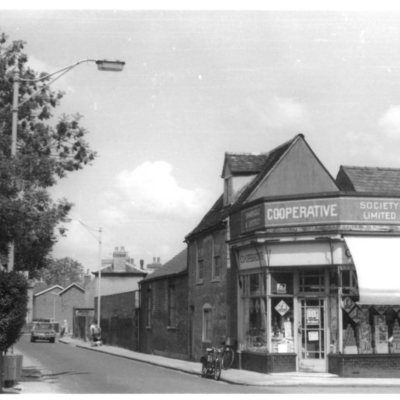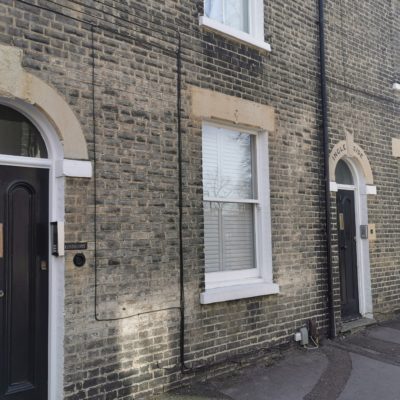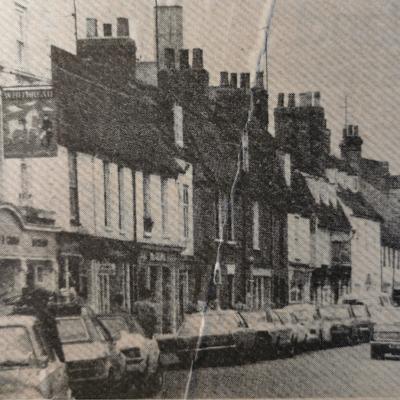Search by topic
- archaeology
- Building of Local Interest
- charity
- church
- crime
- dressmaker
- fire
- Great Eastern Railway
- Listed building
- Mapping Relief
- medieval
- oral history
- poverty
- Public House
- Rattee & Kett
- Religious House
- Roman
- scholar
- school
- Then and Now
- tudor
- women
- work
- world war one
- world war two
Search by text
New Court, King Street
History of New Court, King Street
1861
(1)
Thomas Quinsee, 36, carpenter, b Cambridge
(2)
Susannah Creek, 84, proprietor of houses, b Suffolk,
(3)
Mary Ann Youngman, 67, fund holder, b Cambridge
(4)
‘Visiting Friends’
(5)
William F Tuxford, 35, boot closer, b Middlesex
(6)
Frederick Adams, 40, tailor, b Cambridge
(7)
Mark Cartwright, 50, tailor, b Huntingdon
(8)
Charles Tingay, 56, baker, b Beds
(9)
Elizabeth Quinsee, 63, laundress, b Cambridge
(10)
John Evans, 42, cabinet maker, b Cambridge
(11)
William Payne, 49, bricklayer, b Essex
(12)
William Dace, 51, musician, b Essex
1901
(1) Urban Feakes
(2) David Newland
(3) Kate Caldecott
(4) John Hogg
(5) Eliza Luescher
(6) William Searle
(7) George Gillson
(8) Eliza Carter
(9)
Samuel Neal, 52, coalyard labourer
Ann
Julia, domestic servant
Edith, 16
William, 14, baker’s errand boy
Eliza, 11
Wallis, 9, b Cambridge
1909:
(11) Charles Rowell died here 30.8.1909. he had previously lived at 7 Garden Walk, the Maypole Inn, 19 Milton Road and the Bleeding Heart Chesterton.
3.9.1901: (Cambridge Independent Press) death of Charles Rowell: DEATH OF CHARLES ROWELL. Famous Long Distance Runner’s Chequered Career. The death occurred at his residence, in King-street, Cambridge, on Monday evening of “Charlie” Rowell, the famous long distance runner. Rowell was the son of Mr. Michael Rowell of Old Chesterton, and was born 53 years ago. From his youth onwards he was a very keen sportsman and early gave evidence of the wonderful pace and marvellous stamina, which afterwards made him famous.
About 25 years ago was in his prime, and accomplished some fine performances over distances which called for exceptional endurance. In hundred-mile runs against the clock and in six-day go-as-you-please he was seen to great advantage, and by receiving financial support he was able to carry out several successful tours in America, returning to Cambridge with a good round sum of money. He also won the silver belt presented by the late Sir John Astley three times in succession, and the coveted belt became his own property. After his American tours he gave exhibitions of running all over the British Isles, and when he finally retired from the track he was the possessor of no small amount of money. His retirement, however, brought with it adherence to the turf, and owned a few racehorses, one of which was named Jake Kilrain, after the American boxer. His little fortune, however, was soon depleted, the latter years of his life being spent in penury. Last year he was induced to train for and start in a professional Marathon race from Windsor to the Stadium, but the strain seemed too much for him. and his already undermined constitution was badlv shattered the restrictions of training, so that during the past few months a breakdown in health appeared possible at any moment.
His first visit to America was in 1879 and probably his greatest triumph was his victory over Corkey. The records which Rowell set up in 1882 still stand in his name. They are 85 miles to 150, 161 to 231, and 240 to 350. His time for 100 miles was 13hrs. 26min. 30sec, 200 miles 35hrs. 9min. 28sec., and 300 miles 58hrs. 17min. 6sec.
Rowell was also greatly interested in pugilism, and trained Charles Mitchell for the latter’s celebrated fight (bare fist) with John L. Sullivan, which was decided at Apremont, near Chantilly, on March 10th. 1888. Rowell was amongst those arrested in connection with that encounter.
In his younger days Rowell was attached to one of the University boat-yards in Cam*bridge and with the brothers W and C Asplin assisted in the work of getting the Varsity and college crews boated at Winters. Rowell was also a sculler of average merit and won several races on the Cam.
3.9.1909: buried at Mill Road Cemetery, Cambridge
10.9.1909 Cambridge Independent Press: The funeral of Charles Rowell, whose death was announced in our last issue, took place at the Mill-road Cemetery last Friday afternoon, the officiating clergyman being the Rev. D. J. Davies, curate of Holy Trinity. The principal mourners were Mrs. Rowell (the widow), Mr. M. Howell, jun., Mr. and Mrs. Chas Asplin and Mr. and Mrs. J. Cook. Among those present were Mr. J. Simpson, Mr. F. W. Goodfellow representing the Olympic champions of the world tug-of-war team, and Mr. F. Goodfellow. There were a number of beautiful wreaths.
1913:
- Urban Feakes, butcher
- David Newling, groom
- Mrs J Steptoe
- Sidney J Carter
- Mrs E Carter
- William Searle, tailor
- George Gilson, blacksmith
- Robert A Carter
- Samuel Neal, labourer
- Charles, Osler
- Walter Moore
- Joseph Arthur Rawlinson
- William Webb, tailor
1962:
- Mrs H Sandford
- Mrs Nightingale
- Lucas Owen
- Kenneth R Diaper
- Mrs M Fletcher
- Mrs Webb
- Ivan J Diver
- Mrs Carter
- Mrs Booth
- –
- Mrs F Cole
- Charles Norris
Contribute
Do you have any information about the people or places in this article? If so, then please let us know using the Contact page or by emailing capturingcambridge@
License
This work is licensed under CC BY-NC-SA 4.0










